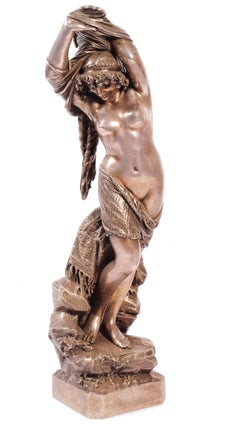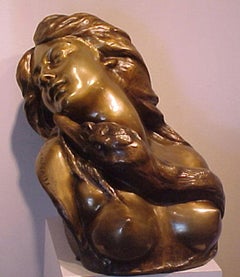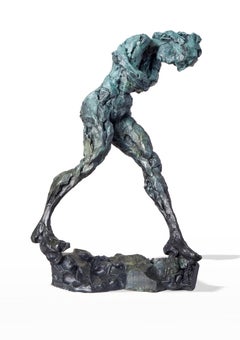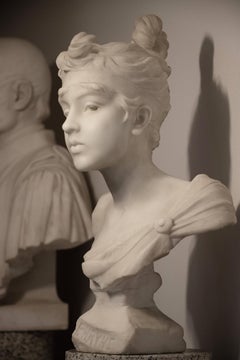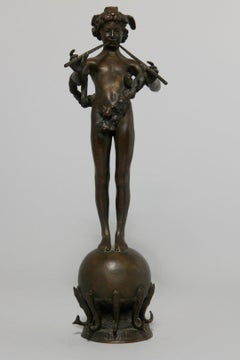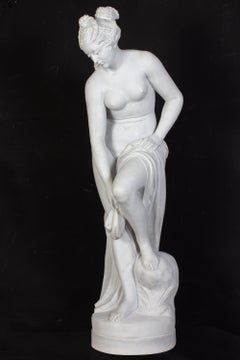1880s Nude Sculptures
to
1
1
Overall Width
to
Overall Height
to
16
80
372
657
8
13
29
31
4
10
26
23
41
33
4
2
2
1
1
1
1
1
2
2
1
1
Period: 1880s
Odalisque - Silver-plated Bronze Sculpture by Giuseppe Salvi - 1886
Located in Roma, IT
The Odalisque is an original decorative object realized by Giuseppe Salvi in 1886.
Silver-plated Bronze representing a young odalisque,
Sign, place and...
Category
1880s Nude Sculptures
Materials
Bronze
Leda and the Swan
Located in West Hollywood, CA
Presenting a magnificent early Art Nouveau bronze by Belgian artist Jef Lambeaux(1852-1908.)
“Leda and the Swan”, is an original Art Nouveau Bronze,...
Category
Art Nouveau 1880s Nude Sculptures
Materials
Bronze
Related Items
Spirit of Gravity - emotive, nude, female, figurative, bronze statuette
Located in Bloomfield, ON
In this thoughtful sculpture by Canadian artist Richard Tosczak, the gestures of a female figure, head bent, arms wrapped, are captured in bronze. Known for his beautiful figurative work, this piece retains the artist’s signature highly textured appearance and green-black patina. Tosczak’s pieces are first conceived on paper in quick pen and ink drawings. The spontaneity of this approach is evident in the almost abstract appearance of the sculpture. This piece is number three in an edition of eight.
“The ineffable, vital qualities of the human spirit (is what I’m trying to communicate.)” - Richard Tosczak
Born in Belgium, Richard Tosczak studied philosophy and sculpture at the University of Alberta. At that time, Tosczak began working in steel and was influenced by a number of his professors who appreciated the work of a British abstract sculptor, Sir Anthony Caro considered one of the greatest sculptors of his generation. Further studies were pursued in France with another internationally acclaimed classic sculptor, Martine Vaugel...
Category
Contemporary 1880s Nude Sculptures
Materials
Bronze
$12,500
H 23.5 in W 6 in D 5.5 in
Phryne - Marble Bust of a Beautiful Young Woman Perfect Silhouette Art Nouveau
Located in Miami, FL
Emmanuel Villanis was well known primarily for his bronzes of beautiful young women. With Phryne, the sculptor is working in marble. Since stone is not in the least forgiving, it's...
Category
Art Nouveau 1880s Nude Sculptures
Materials
Marble
$29,000
H 25.5 in W 13.5 in D 12 in
Bust of a young woman / - The Opulence of Beauty -
Located in Berlin, DE
Anton Nelson (i.e. Antoine Joseph van den Kerckhoven) (1849 Brussels - after 1910 ibid.), Bust of a young woman, c. 1890. Patinated bronze on cast base, 30 cm (total height) x 20 cm ...
Category
Art Nouveau 1880s Nude Sculptures
Materials
Bronze
$767
H 11.82 in W 7.88 in D 5.52 in
Eugene Marioton - Bronze Statue
Located in Berlin, DE
Eugène Marioton
französisch, 1854 - 1933
Muscular Nude Male Bronze Eugene Marioton - Bronze Statue, um 1900
A handsome and very fit partially draped young nude male with rippling mu...
Category
Jugendstil 1880s Nude Sculptures
Materials
Bronze
Charles Perron "Woman with Iris" Patinated Bronze
Located in Astoria, NY
Charles Theodore Perron (French, 1862-1934) "Woman with Iris" Gilt and Patinated Bronze Sculpture, late 19th century, the standing figure upholding Irises, on a circular base, signed...
Category
Art Nouveau 1880s Nude Sculptures
Materials
Bronze
Apollo
Located in PARIS, FR
"Apollo" by Henri Bouchard (1875-1960)
An Art Deco period masterpiece!
Exceptional bronze sculpture with a golden-brown patina
Signed " H. Bouchard "
Unique piece
This work personifies Apollo, god of the Arts. Represented here as Apollo Musagète, leader of the procession of muses and winner of the serpent Python.
This subject was commissioned to adorn the entrance to the Palais de Chaillot in Paris, and whose monumental bronze is still exhibited there.
To participate in the Venice Biennale in 1938, Henri Bouchard had reduced in 1937 the large Apollo of the Palais de Chaillot, which had not yet been installed.
Vintage cast by Bisceglia (cast founder stamp) made during the artist's lifetime.
Incised dedication below signature : " à mon cher ami E. Sandoz "
This is a unique cast made for the sculptor Edouard-Marcel Sandoz (1881-1971).
This cast was exhibited at the 1938 Venice Biennale.
France
1937
height : 82 cm
width : 45 cm
depth : 30 cm
weight : 31,2 kgs
Stickers under the bronze cast :
- Sticker mentioning that this cast has been exhibited at the Venice Biennale of 1938 under the number 354 ("Biennale Internaz. d'Arte Venezia – 1938 – XVI – 354").
- Sticker mentioning that this cast went through Italian customs ("ne – merci – dogana italiana – visitate - 9622")
- Damaged Sticker mentioning the name ("A…") and the address ("25…") of the owner of the cast (maybe for the workshop "Atelier Henri Bouchard", 25 rue d’Yvettes, 75016 Paris).
Provenance :
- Edouard-Marcel Sandoz, Paris, according to the dedication.
- Property from the Collection of Seymour Stein (entrepreneur and founder of Sire Records, famous American record label ; and avid collector of 19th and 20th century fine art...
Category
Art Deco 1880s Nude Sculptures
Materials
Bronze
Émile Louis Picault Bronze Sculpture
Located in Astoria, NY
Emile Louis Picault (French, 1833-1915) "Paris" Patinated Bronze Sculpture, late 19th century, the standing figure holding a golden apple, signed to base. 32" H x 12" W x 12" D. The ...
Category
Art Nouveau 1880s Nude Sculptures
Materials
Bronze
$6,400
H 32 in W 12 in D 12 in
Antique Orientalist Arab Slave Trader Female Nude Group Cold Painted Bronze 1910
Located in Portland, OR
A very large 24" (61cm) Franz Xavier Bergmann (1861-1936) cold painted bronze group statue, signed, Austria, circa 1910.
The bronze in the Orientalist manner & depicts a young slave ...
Category
Art Nouveau 1880s Nude Sculptures
Materials
Bronze
Franz BergmannAntique Orientalist Arab Slave Trader Female Nude Group Cold Painted Bronze 1910, 1910
$4,500
H 28 in W 11.75 in D 12 in
Figurative bronze with a literary mythological theme from the early twentieth century
Located in Florence, IT
Early 20th-century Art Nouveau decorative bronze depicting a smiling mermaid carried by a wave above a fountain with a mask.
The reference is to the fairy tale by writer Hans Christ...
Category
Art Nouveau 1880s Nude Sculptures
Materials
Bronze
$2,126
H 9.45 in Dm 7.09 in
Mother Happiness / - The ecstasy of maternal joy -
Located in Berlin, DE
Johannes Boese (1856 Ostrog - 1917 Berlin), Mutterglück, um 1910. Goldbraun patinierte Bronze auf gegossener rechteckiger Plinthe, montiert auf zweifarbigem Marmorsockel (9,5 cm Höhe...
Category
Art Nouveau 1880s Nude Sculptures
Materials
Bronze
$3,969 Sale Price
20% Off
H 24.02 in W 7.09 in D 4.53 in
The Kiss
Located in PARIS, FR
The Kiss
by Alfred PINA (1887-1966)
Bronze group with a brownish dark green patina
signed on the base "A. Pina"
cast by "A. Valsuani" (foundry stamp)
France
circa 1927
height 51,5...
Category
French School 1880s Nude Sculptures
Materials
Bronze
Apollo
Located in PARIS, FR
Apollo
by Pierre-Marie POISSON (1876-1953)
Sculpture with a dark old gold patina
signed on the base "P. Poisson"
Cast by Bisceglia (with the foundry stamp)
France
circa 1927
heig...
Category
French School 1880s Nude Sculptures
Materials
Bronze
Previously Available Items
Pan of Rohallion, 1889-90 classical bronze sculpture
Located in Beachwood, OH
Frederick W. MacMonnies (American, 1863-1937)
Pan of Rohallion, 1889-90 (Garden 22)
Bronze
Signed on base, 'ROMAN BRONZE WORKS NY' at base
14.25 x 4 x 6 inches
A sculptor of classical figures, American-born Frederick MacMonnies...
Category
1880s Nude Sculptures
Materials
Bronze
H 14.25 in W 4 in D 6 in
Fabulous Neoclassical Marble Sculpture of Bathing Venus 1880'
Located in Rome, IT
Late 19th century French finely carved white Carrara marble figure of Bathing Venus . The marble base is not included in the price.
AFTER CHRISTOPHE-GABRIEL ALLEGRAIN (FRENCH, 1710-1795): A 19TH CENTURY MARBLE FIGURE...
Category
Academic 1880s Nude Sculptures
Materials
Marble
French Carrara Marble Sculpture, 19th Century Nude Neoclassical Mother & Child
Located in Miami, FL
19th Century French sculptor Vanet depicts the classic Mother and Child where the child is harmoniously nestled in the arms of the mother. It's executed in the Neoclassical style. ...
Category
French School 1880s Nude Sculptures
Materials
Marble
H 17.75 in W 14 in D 9 in
Jupiter & Hebe, Romantic French Bronze
Located in Greenwich, CT
A marvelous bronze picturing the allegory of Jupiter and Hebe, a favorite theme in sculpture during the 19th century. Conceived of in 1886 and originally executed in marble, Coulon l...
Category
Academic 1880s Nude Sculptures
Materials
Bronze
Exceptional Italian Sculpture of Paulina Bonaparte Borghese after Anotino Canova
Located in Queens, NY
Exceptional neoclassical Italian alabaster and iridescent polychrome metal sculpture of Paulina Bonaparte Borghese, circa 1880.
This iconic, elegant sculpture depicts Paulina Bonaparte as Venus Victrix (Venus (Victorius) after the famous model by Antonio Canova which is now at the Borghese Gallery in Rome.
The nude figure reclining on an iridescent polychrome rainbow chaise lounge holding an apple in her hand on a black marble base with bronze paw feet.
This iconic marble figure is after the celebrated sculpture by Antonio Canova of Pauline Borghese, sister of Napoleon Bonaparte and wife of Prince Camillo Borghese. It was commissioned by Camillo, her second husband and executed in Rome from 1805-1808, after her marriage into the Borghese family in 1803. It was moved to the Galleria Borghese in Rome circa 1838 where it still resides.
Canova was renowned for his neoclassical sculpture which skillfully intertwined antique influences with modern artistic ideals, in this case representing the famed Roman Princess...
Category
1880s Nude Sculptures
Materials
Alabaster, Marble, Metal, Bronze
H 15 in W 22 in D 9 in
Recently Viewed
View AllMore Ways To Browse
Walter Henry Sweet Painting
Warhol Kimiko Powers
Warhol Lincoln Center Ticket
Wedding At Cana
William Blackman
William Dunlap
William Edward Millner
William H Clapp
William Lester Stevens Rockport In Winter
William Watson Jnr
William Yeaman
Xavier Valls
Zev Daniel Harris
Zhiwei Tu
1983 Americas Cup Poster
19th Century Art Borzoi
Aaron Kilpatrick
Adolphe Alexandre Lesrel
